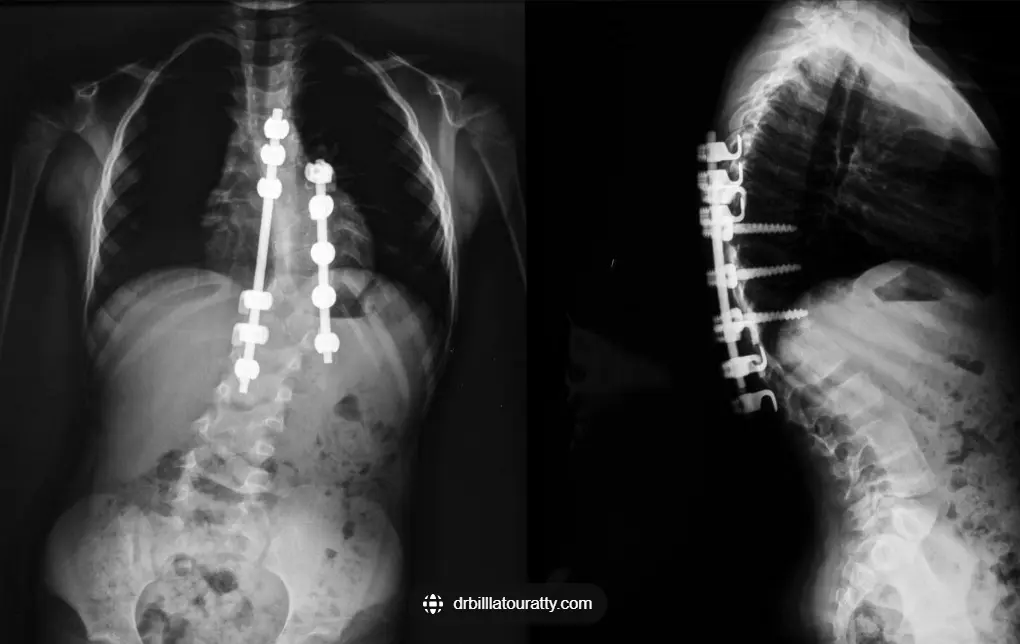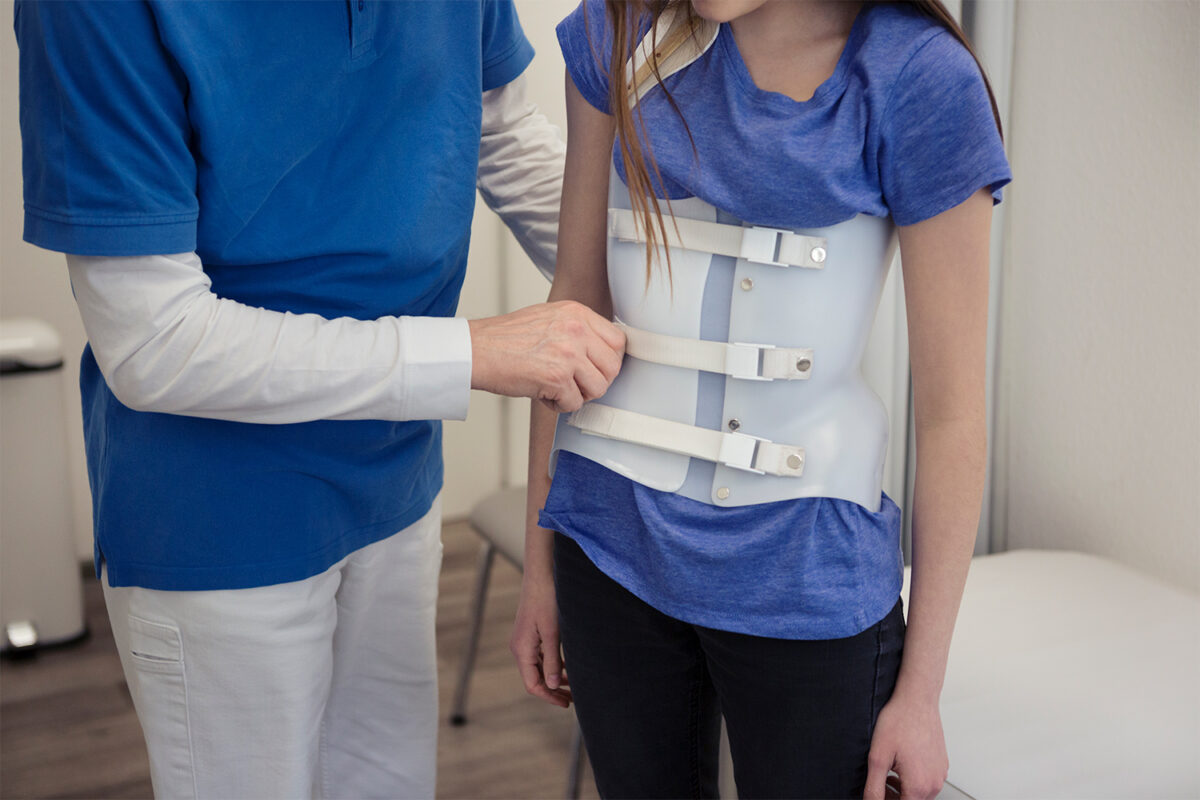Scoliosis is a medical condition characterized by an abnormal curvature of the spine, affecting approximately 2-3% of the population, with the majority of cases diagnosed in adolescence. Mild cases of scoliosis can often be managed through conservative treatments such as physical therapy and bracing, but more severe cases may require surgical intervention. In recent years, scoliosis tethering, also known as vertebral body tethering (VBT), has emerged as a promising alternative to traditional spinal fusion surgery .
Understanding Progressive Scoliosis
The Nature of Progressive Scoliosis
Progressive scoliosis refers to a condition where the curvature of the spine worsens over time, leading to complications such as pain, respiratory issues, and reduced mobility. Monitoring the progression of scoliosis typically involves regular X-rays and physical examinations. When the curvature exceeds a certain threshold, surgical intervention is often recommended to halt further progression .

What is Scoliosis Tethering?
How Does Vertebral Body Tethering Work?
Scoliosis tethering (VBT) is a surgical procedure designed to correct spinal curvature while preserving spinal flexibility. Unlike traditional spinal fusion, which permanently fuses vertebrae using metal rods and screws, tethering uses a flexible cord placed along the concave side of the spine. The tether is tightened during surgery to gradually straighten the spine and promote balanced growth in the affected area .
The Procedure of Scoliosis Tethering
Steps Involved in VBT Surgery
The scoliosis tethering procedure begins with the surgeon making small incisions to access the spine. The flexible tether is inserted along the concave side, passing through the vertebral bodies. Screws or anchors are used to secure the tether, which is then tightened to correct the curvature and guide spinal growth. The procedure is typically performed using minimally invasive techniques, leading to reduced blood loss, quicker recovery times, and smaller scars compared to traditional surgery .
Benefits and Risks of Scoliosis Tethering
Advantages of Tethering
One of the main benefits of scoliosis tethering is that it allows for continued spinal growth and preserves flexibility, especially in young patients. This is a significant advantage over spinal fusion, which limits movement in the fused areas. Studies also suggest that tethering has a lower risk of complications such as infection and blood loss compared to fusion surgery .
Potential Risks and Complications
Like any surgical procedure, scoliosis tethering carries risks. These may include nerve damage, implant failure, and the need for revision surgery. Additionally, the long-term outcomes of tethering are still under study, and it remains unclear how the procedure will impact patients as they age. Patients and their families should thoroughly discuss these risks with their healthcare provider before proceeding with surgery .

Effectiveness of Tethering in Managing Progressive Scoliosis
Research and Outcomes
Several studies have demonstrated positive outcomes for scoliosis tethering. For instance, a study published in the 骨・関節外科ジャーナル reported that patients who underwent VBT experienced an average spinal correction of 50% . Another study in the スパインジャーナル noted similar results, with patients achieving a mean correction of 45% .
In addition to curvature correction, tethering has been linked to improved quality of life. Research published in the 小児整形外科ジャーナル indicated that patients who underwent tethering reported less pain and better physical function compared to those who had spinal fusion, suggesting that VBT may offer significant functional benefits .
Comparing Tethering with Traditional Scoliosis Treatments
Fusion vs. Tethering: A Comparative Analysis
While both spinal fusion and tethering aim to correct spinal curvature, they differ in their approaches and long-term effects. Spinal fusion permanently stabilizes the spine by fusing vertebrae together, which can limit flexibility and affect daily activities. Conversely, tethering maintains spinal flexibility and allows for growth, making it an appealing option for younger patients who are still developing .
Candidates for Scoliosis Tethering
Who is Suitable for VBT?
Scoliosis tethering is typically recommended for patients who have a flexible spinal curve and are still growing. Candidates usually have a curvature within a specific range determined by X-rays. Additionally, patients should be in good overall health and have realistic expectations about the surgery’s outcomes .
Preparing for Scoliosis Tethering Surgery
Preoperative Assessment and Preparation
Before surgery, patients undergo a comprehensive evaluation to determine their suitability for VBT. This includes X-rays, physical exams, and possibly other diagnostic tests. Patients will also need to discuss the procedure in detail with their healthcare provider and address any concerns. In the days leading up to the surgery, patients may be instructed to stop certain medications and follow specific dietary guidelines .
Recovery and Rehabilitation After Tethering Surgery

Post-Surgery Recovery Process
Recovery from scoliosis tethering surgery typically involves a few days in the hospital, where patients are monitored and given pain management support. After discharge, patients follow a rehabilitation plan that includes physical therapy exercises to strengthen the back and improve flexibility. Regular follow-up visits are essential to track recovery progress and make any necessary adjustments .
Long-term Outcomes and Follow-up Care
Monitoring and Maintaining Results
Long-term studies on scoliosis tethering are ongoing, but early research suggests that patients can maintain correction over time. A study in the 小児整形外科ジャーナル found that patients retained their spinal correction at a follow-up period of 2.5 years . Regular follow-up care, including X-rays and physical assessments, is critical to monitor spinal stability and detect potential complications .
Conclusion: The Future of Scoliosis Tethering
Scoliosis tethering offers a promising alternative to traditional fusion surgery, especially for younger patients. The procedure allows for continued spinal growth and flexibility while addressing the abnormal curvature. Although long-term data is still being collected, early results are encouraging, and ongoing advancements in surgical techniques will likely improve patient outcomes. As more research emerges, scoliosis tethering is expected to play an increasingly important role in the management of progressive scoliosis.
参考文献
- Newton PO, Marks MC, Bastrom TP, et al. “Vertebral Body Tethering for the Treatment of Adolescent Idiopathic Scoliosis.” 骨・関節外科ジャーナル. 2019;101(21):1921-1931. doi: 10.2106/JBJS.19.00455.
- Samdani AF, Ames RJ, Kimball JS, et al. “Vertebral Body Tethering in Skeletally Immature Patients with Idiopathic Scoliosis: Results of a 2-year Follow-up.” スパインジャーナル. 2015;15(10). doi: 10.1016/j.spinee.2015.07.442.
- Braun JT, Akyuz E, Udall H, et al. “Anterior Vertebral Body Tethering Instead of Fusion for Idiopathic Scoliosis.” 小児整形外科ジャーナル. 2019;39(8). doi: 10.1097/BPO.0000000000001425.
- Miyanji F, Newton PO, Samdani AF, et al. “Safety and Efficacy of Vertebral Body Tethering for the Treatment of Idiopathic Scoliosis.” 小児整形外科ジャーナル. 2020;40(6). doi: 10.1097/BPO.0000000000001525.
- Rushton PR, Nasto LA, Parent EC, et al. “Results of the First US FDA IDE Clinical Trial for the Use of Vertebral Body Tethering in Pediatric Idiopathic Scoliosis.” 小児整形外科ジャーナル. 2021;41(3). doi: 10.1097/BPO.0000000000001769.
- Braun JT, Ogilvie JW, Akyuz E, et al. “Anterior Vertebral Body Tethering for Skeletally Immature Patients with Idiopathic Scoliosis: Prospective Evaluation with 24-month Follow-up.” 背骨. 2019;44(18). doi: 10.1097/BRS.0000000000003058.
- Smith JS, Shaffrey CI, Sansur CA, et al. “Vertebral Body Tethering as an Alternative to Posterior Spinal Fusion in the Treatment of Pediatric Scoliosis.” 臨床脊椎外科. 2018;31(1). doi: 10.1097/BSD.0000000000000620.
- Samdani AF, Pahys JM, Ames RJ, et al. “Anterior Vertebral Body Tethering for Adolescent Idiopathic Scoliosis: A Retrospective Review of 32 Patients at 2-year Follow-up.” 小児整形外科ジャーナル. 2014;34(4). doi: 10.1097/BPO.0000000000000163.
- Cahill PJ, Pahys JM, Asghar J, et al. “Vertebral Body Tethering for Idiopathic Scoliosis: Early Outcomes from an FDA Investigational Device Exemption Study.” 脊椎変形. 2020;8(3):391-399. doi: 10.1007/s43390-020-00131-9.
- Johnston CE, Erickson MA, Palazzolo KL, et al. “Vertebral Body Tethering vs Posterior Spinal Fusion for Adolescent Idiopathic Scoliosis: A Comparison of Postoperative Outcomes.” 小児整形外科ジャーナル. 2022;42(3). doi: 10.1097/BPO.0000000000001970.

